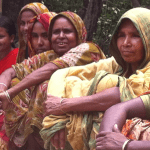Announcing Kiva’s Bold New Impact Strategy: The Nonprofit Microfinance Pioneer Shares its Refined Approach — And Unveils the Process Behind its Development
Both social enterprises and nonprofits need inspiring missions to thrive, and when those missions are coupled with well-crafted impact strategies, the change they seek to make is more likely to become reality. Missions define our destination and impact strategies are the navigational tool, steering us toward our objectives and ensuring we stay on course.
Today, we’re excited to share Kiva’s latest impact strategy, the result of years of hard work. This strategy will play a pivotal role in shaping the next phase of our journey. I’ll discuss the key elements of the strategy below, while also unveiling the process behind its creation, so it can serve as a resource for others shaping their own impact strategies.
Kiva’s journey: Scaling through innovation
Kiva’s story began in March 2005, when Kiva.org launched as one of the world’s first crowdfunding sites, enabling users everywhere to fund microloans for entrepreneurs and individuals across the globe. Since our first loan — $500 to an entrepreneur named Elizabeth for the expansion of her fishmongering business in Uganda — our community of lenders has taken up our mission with vigor. Over the past 18 years, 2.2 million Kiva lenders have facilitated over $2 billion in loans to over 5 million people like Elizabeth all around the world.
An important part of our strategy has involved building partnerships with a network of lending partners — microfinance institutions, nonprofits, social enterprises and NGOs. Kiva has invested in creating deep values-aligned relationships with nearly 600 partners in 95 countries, and that is a key reason why we have been able to create local impact at a global scale over a sustained period of time.
Along the way, many innovations to our core model have continued to fuel our impact growth. For instance, in the U.S., we introduced a unique model of social-underwriting and partnerships with local “hub” community organizations serving the needs of entrepreneurial ecosystems. This program allows Kiva to extend zero-interest, zero-fee loans directly to underserved entrepreneurs. Another innovation was the launch of Kiva Capital, formed as a complementary offering to Kiva.org for the purpose of reaching more underserved borrowers through larger-sized loans to many of the same lending partners and social enterprises served by our crowdfunding platform. Investor capital is efficiently deployed through funds like the Kiva Refugee Investment Fund, where we are making a meaningful difference in the lives of tens of thousands of refugees — an often-overlooked segment of the entrepreneur population.
While the progress and milestones we’ve achieved through these and other innovations are remarkable, we recognize that there is much more to do to maximize both the breadth and depth of our impact. Not only is it necessary to reach more of the 1.4 billion adults who still lack access to basic financial services, it is also equally important to continue generating measurable, positive outcomes for the people we serve. The impact strategy we’ve defined takes these needs into account as we work to expand upon the progress we’ve made.
The power of an impact strategy: Building collaboration and clarity
Working on a global scale requires collaboration among diverse stakeholders. An impact strategy serves as the glue that brings these stakeholders together, aligning their efforts to achieve shared goals.
A well-defined impact strategy helps address three questions:
- Who will we serve (our focus)?
- What outcomes do we aim to create, and how will we measure them?
- What will be the scale of our impact?
Having answers to these questions serves as a powerful asset for organizations, allowing them to build trust and clarity in several key ways. For instance, an impact strategy provides:
- Alignment and Focus: It aligns the entire organization behind common goals, and this shared focus aids in making informed decisions, especially in resource allocation and strategic planning. When everyone moves in unison, the organization’s potential is maximized.
- Transparency: By establishing clear measures of success, organizations can objectively evaluate their impact, and they are equipped with data that can be shared openly with their stakeholders.
- Mission Advocacy: A well-defined impact strategy allows organizations to crisply articulate their mission to potential partners. This clarity attracts like-minded partners and fosters enduring relationships.
- Continuous Improvement: Establishing a data-driven approach to measuring outcomes enables continuous improvement. By understanding what initiatives are working, organizations can improve the effectiveness of their efforts.
Kiva’s Renewed Impact Strategy
Since our founding, Kiva’s mission has remained focused on impact through financial access. As we’ve strived to reach even more underserved communities, we recognized that we needed to sharpen our impact focus, clarify our destination, and find new ways to measure progress through a more comprehensive impact strategy.
Our first step in this process was to address the three broad questions mentioned above. At Kiva, we have multiple stakeholders — employees, lending partners, lenders, volunteers, strategic partners and donors — and we requested input from this comprehensive network. Each phase of the impact strategy development was refined as we gathered more data and input, and we see this as an ongoing, critical component of the strategy. We seek for this plan to be a living document, one we will continue to improve upon as we implement the strategy and learn from the results.
Who will we serve? – Kiva’s four target populations
We began with the crucial task of identifying the populations we aim to serve. However, when your reach extends to millions of diverse individuals worldwide, how do you determine which populations to prioritize?
To address this challenge, we asked ourselves three questions:
- Where do we identify the most pressing needs in the world?
- Where have we achieved the greatest success in the past?
- In what areas are we uniquely positioned to foster sustainable impact moving forward?
In answering these questions, we uncovered four key population segments that will form the heart of our impact strategy:
Underbanked women: Women face disproportionate barriers in accessing finance due to factors such as gender biases, lack of collateral, and societal limitations that prohibit economic opportunities. Over 740 million women remain unbanked, and there are 72 countries where women are prohibited from opening bank accounts or obtaining credit. With over 80% of Kiva loans going to female borrowers, our model drives impactful, long-standing change for women, proven by our data and research findings. As a result, Kiva is uniquely positioned to address inequities facing women by scaling gender-smart funding for women entrepreneurs, thereby contributing to a more diverse and resilient economy, which is crucial for sustainable development.
Refugees and displaced people: Over 100 million people worldwide have been forced to leave their homes due to human and natural disasters, and this number is forecast to increase to over 1 billion people by 2050. For refugees and displaced people, access to financial capital is critical to rebuilding lives. Kiva began lending to refugees in 2016, after assessing that traditional financial service providers were reluctant to lend to these individuals due to the misconception that they were too risky. Funding from Kiva has helped dispel this myth, with demonstrated repayment rates of 97%, on par with other populations funded on Kiva.org. Our success and passion for creating greater opportunity for refugee communities gives us confidence that we will continue to make a meaningful difference.
Systemically marginalized communities in the U.S.: Since the launch of Kiva U.S. in 2011, we have learned a great deal about the inequitable access to capital that U.S. business owners face, particularly those from systemically marginalized communities. Our data has shown that 76% of Kiva U.S. borrowers report they could not find an alternative source of funding, demonstrating that Kiva loans are a lifeline for countless businesses. These zero-fee, zero-interest loans are uniquely positioned to address the urgent need for access to capital among entrepreneurs throughout the U.S who face systemic obstacles. Entrepreneurship is vital to creating healthy and vibrant local communities, and we will continue to keep this as a core focus for Kiva.
Communities impacted by climate change: Climate change disproportionately impacts unbanked and financially underserved populations globally, and as the impacts of climate change continue to compound, so do the dire consequences for these groups. Kiva gives communities resources to adapt to existing climate-related challenges and build resilience for whatever comes next, particularly for smallholder farmers. For instance, we support an array of climate-smart loans for organic farming and biodigesters, solar power, clean water and sanitation, improved energy efficiency, and more. It’s a moral obligation for us to be a part of the climate solution, addressing this defining crisis of our generation and supporting those who are most impacted by its effects.
How will we measure outcomes?
We know that scale without meaningful depth is not “impact,” so we’re working to ensure that we better understand the sustained impacts of Kiva’s loans on the outcomes of our borrowers. To that end, to complement our internal impact measurements and surveys of partners, we began incorporating independent studies in recent years. We worked with an impact measurement firm, 60 decibels, as a founding partner of the Microfinance Index — the world’s first microfinance social performance report based entirely on data from the people it serves. Released in 2022, the report included input from over 18,000 microfinance customers across 41 countries, who participated in interviews for the study and reported the outcomes they’ve experienced, such as improved quality of life, increased incomes and better resilience against economic shock.
With the knowledge gained from this exercise, we decided to take a targeted approach and conducted an in-depth study of the impact of Kiva’s loans on our U.S. borrower community. The resulting report, Kiva U.S. Small Business Insights (created in partnership with 60 decibels) helped us learn a great deal about the impact of our loans on supporting small businesses’ growth, creating financial security, and helping build credit and confidence for our borrowers. In addition, this approach helped us establish a benchmark of the outcome goals we aim to assess across all of Kiva’s borrowers going forward, with the principal goals including increased business income, improved ability to manage finances, improved confidence and increased savings.
To enable this measurement on an ongoing basis, we’re proud to announce an expanded partnership with 60 decibels, which will include new impact assessment studies and a comprehensive impact dashboard. This effort will not only allow us to gain a continuous understanding of measurable outcomes, it will also enable us to work with our partners to refine products and services that can best address our borrowers’ needs.
How Will We Scale Our Impact?: Goals to spark growth
With our growing understanding of the impact we have achieved thus far, each of our four target populations defined, and the basis of our assessment approach established, the latest step in the ongoing development of our impact strategy has involved setting our sights on audacious goals for the next phase of our evolution.
We set these targets by assessing our historical growth trajectory, with a particular focus on the lives we’ve been able to reach over the past five years. Our aim was to set goals that would challenge us, leading to new product innovations and reinvigorated partnerships. These objectives build on commitments we announced this year at the Clinton Global Initiative for two of our four target populations, and include the following aspirational goals:
- Kiva is committed to supporting 4 million underbanked women by 2028, bringing our total to 8 million women over the course of Kiva’s history. This is double the number of women we have reached through 2023, and women will continue to represent 80% of Kiva’s overall portfolio.
- Kiva is committed to supporting 350,000 refugees and displaced people by 2028, totaling more than 440,000 over the course of Kiva’s history. This represents a significant increase, expanding our refugee lending focus from a pilot effort started in 2016 to a permanent, core focus of our model.
- Kiva is committed to supporting 7,500 systemically marginalized business owners in the U.S. by 2028, totaling more than 15,000 over the course of Kiva’s history. This represents a doubling of the number of systemically marginalized Americans we have reached thus far.
- Kiva is committed to supporting 500,000 climate-vulnerable people (including smallholder farmers) by 2028, totaling more than 1.1 million over the course of Kiva’s history. This will nearly double the number of climate-vulnerable people we have reached thus far.
Our Shared Calling: Building a Brighter Future Together
Defining impact at social enterprises and nonprofits is not just a matter of measurement: It’s about enhancing effectiveness, accountability, and our overall ability to inspire and drive positive change. It is a means to ensure that businesses and organizations can fulfill their missions and create lasting change in the communities and causes they serve.
Our impact strategy is not just a set of goals. It identifies the lives we aim to reach, the futures we aim to support, and the ripple effects our work will have on communities and individuals around the world. This is not just our mission: It’s a shared calling for collaboration and a brighter, more inclusive future for all
Vishal Ghotge is CEO of Kiva.
Photo courtesy of UN Women/Joe Saade
- Categories
- Finance, Investing, Social Enterprise



